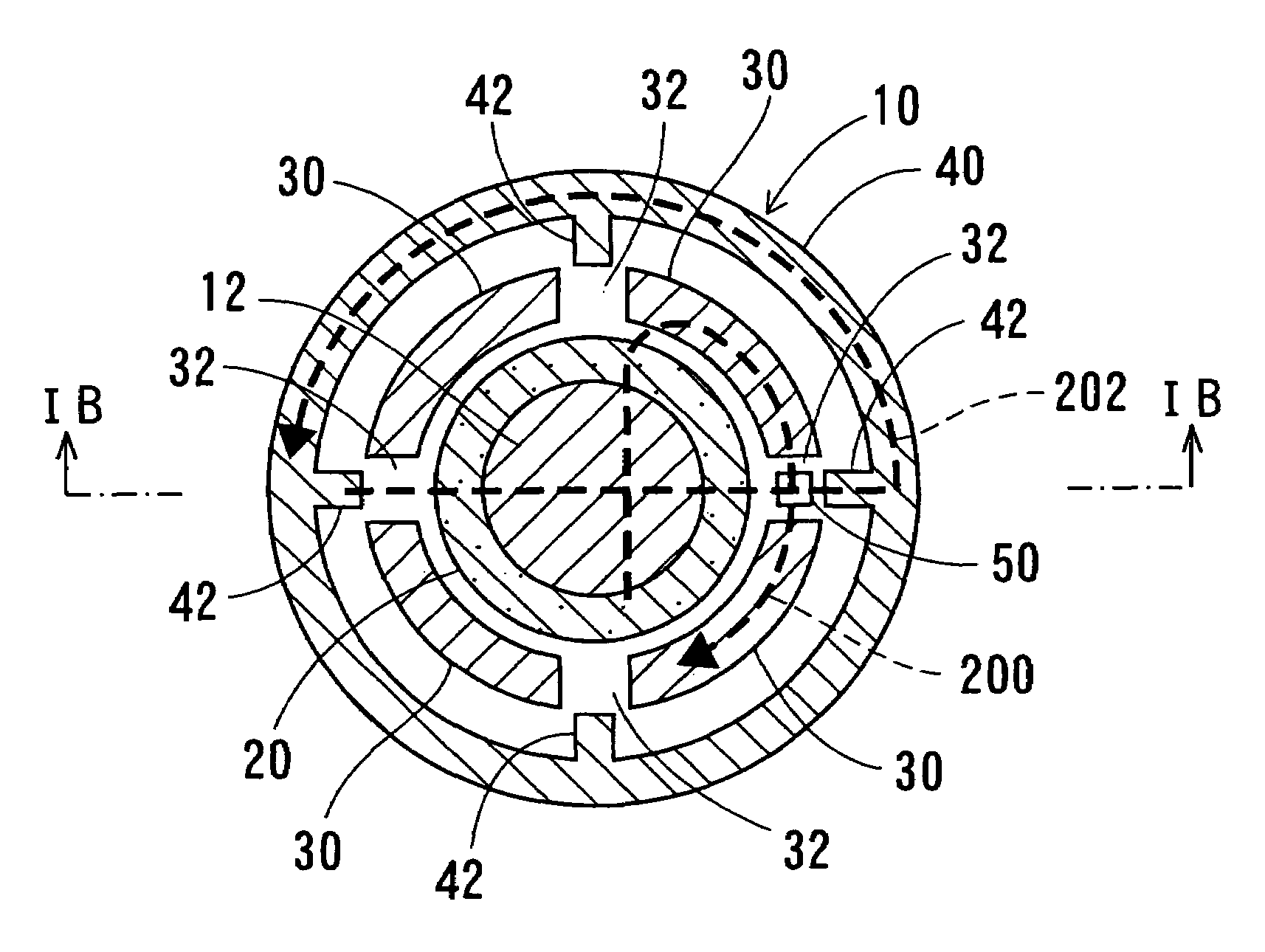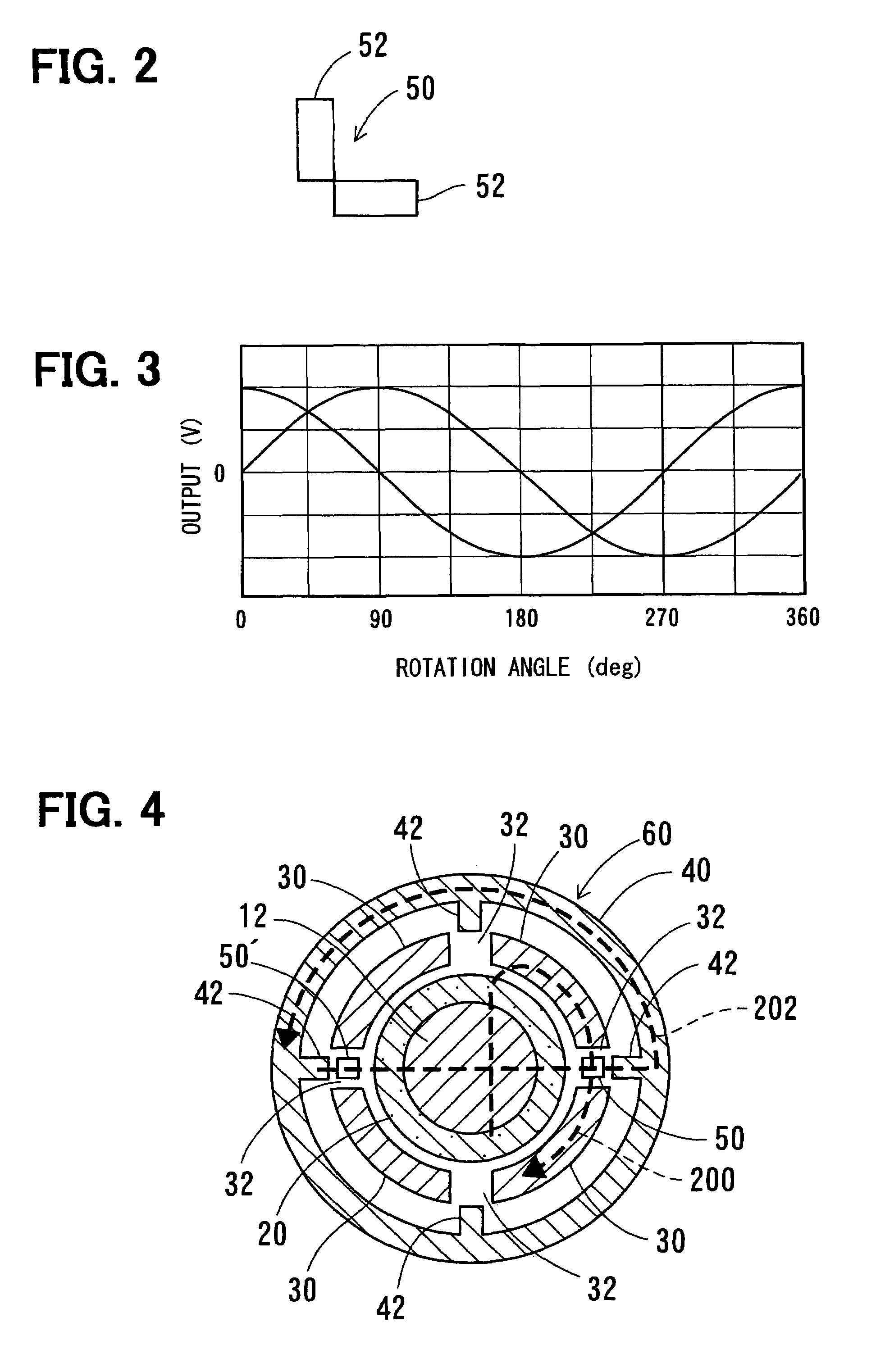Rotation angle using orthogonal magnetic sensing elements in close proximity to each other
a magnetic sensing element and orthogonal technology, applied in the direction of galvano-magnetic devices, galvano-magnetic hall-effect devices, instruments, etc., can solve the problems of temperature difference between the setting direction of two magnetic sensing elements may not be desired, and the difficulty in accurately positioning the magnetic sensing elements, etc., to achieve the effect of accurately detecting the rotation angle of a rotating object and improving the rotation angle detecting
- Summary
- Abstract
- Description
- Claims
- Application Information
AI Technical Summary
Benefits of technology
Problems solved by technology
Method used
Image
Examples
first embodiment
[0029]A rotation angle detecting device according to the invention will be described with reference to FIGS. 1A-3.
[0030]As shown in FIGS. 1A and 1B, a rotation angle detecting device 10 is set around a rotary shaft 12 that is linked with a rotating object (not shown). The rotation angle detecting device 10 is constituted of a ring-shaped permanent magnet 20, four arc-shaped magnetic inner yokes 30, a generally cylindrical magnetic outer yoke 40 and a magnetic sensor 50.
[0031]The ring-shaped permanent magnet 20 is magnetized to polarize in parallel with a radial direction thereof and fixed to the circumference of the rotary shaft 12. The four inner yokes 30 are disposed around the permanent magnet 20 at equal intervals so that gaps 32 can be formed at intervals of 90 degrees. In other words, each of the gaps 32 is positioned around the permanent magnet 20 opposite to, or at 180 degrees from, another of the gaps 32. The cylindrical outer yoke 40 is disposed around the inner yokes 30. ...
second embodiment
[0037]A rotation angle detecting device 60 will be described with reference to FIG. 4. Incidentally, the same reference numeral indicates the same or substantially the same part, portion or component hereafter.
[0038]As shown in FIG. 4, one more magnetic sensor 50′ is disposed in another gap 32 that is located 180 degrees from the first magnetic sensor 50. With this additional magnetic sensor 50′, a variation in the output signal of each of the magnetic sensors 50, 50′ can be easily corrected by combining the output signals of both magnetic sensor 50 and the magnetic sensor 50′. The additional magnetic sensor may be disposed in a gap other than 180 degrees from the first magnetic sensor 50. Two or more additional sensors may be also used.
third embodiment
[0039]A rotation angle detecting device 70 will be described with reference to FIG. 5.
[0040]The rotation angle detecting device 70 is constituted of two pieces of arc-shaped inner yokes 72 and an outer yoke 76 having two projections 78 to provide a pair of gaps 74 so as to be positioned around the permanent magnet 20 opposite to, or at 180 degrees from, the other, instead of four pieces of arc-shaped inner yokes 30 of the first embodiment and the outer yoke 40 having four projections 42 thereof. The inner yokes 72 and the outer yoke 76 with one of the projections 78 confronting the magnetic sensor 50 form magnetic paths 200, 202 to cross each other at the sensor 50 at an angle of 90 degrees, as illustrated by broken lines.
[0041]It is easier to assemble the inner yokes 72 than the first embodiment.
PUM
 Login to View More
Login to View More Abstract
Description
Claims
Application Information
 Login to View More
Login to View More - R&D
- Intellectual Property
- Life Sciences
- Materials
- Tech Scout
- Unparalleled Data Quality
- Higher Quality Content
- 60% Fewer Hallucinations
Browse by: Latest US Patents, China's latest patents, Technical Efficacy Thesaurus, Application Domain, Technology Topic, Popular Technical Reports.
© 2025 PatSnap. All rights reserved.Legal|Privacy policy|Modern Slavery Act Transparency Statement|Sitemap|About US| Contact US: help@patsnap.com



